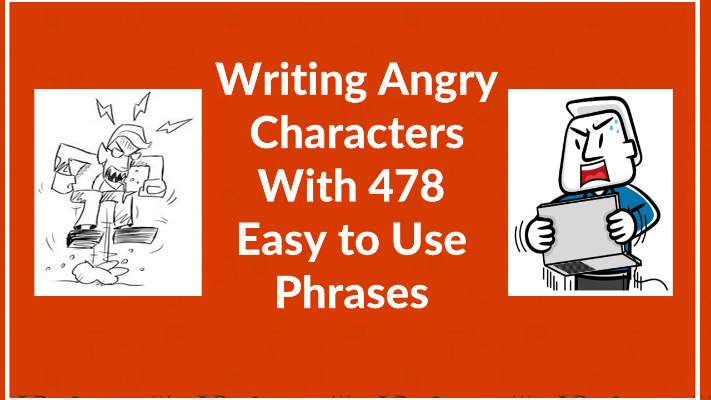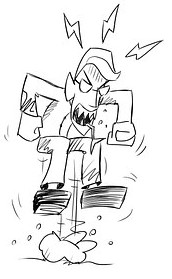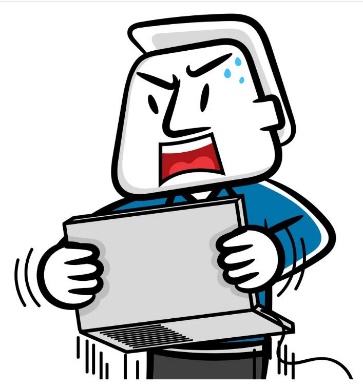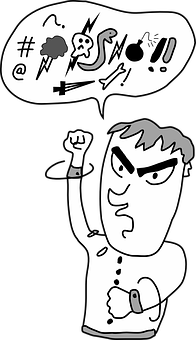
Writing angry characters is challenging. Different personalities express anger in various ways. Few emotions reveal a character’s personality more thoroughly than how they handle anger. Great writers understand the many nuances of anger. We hope this post will help you gain a better understanding of how to write angry characters.
It is a common misconception that anger only manifests in loud, violent behavior. In reality, anger is a complex emotion that a character can express in many ways.
Here are seven different ways a character can express anger.
We have included examples.
In addition to the examples in this post, you can download 412 more phrases to help you write angry characters.
#1. Writing Angry Characters, Annoyance

Annoyance is the most common type of anger. Your character gets upset or frustrated with others. Sometimes it’s the little things in life that bother us the most. Therefore, consider writing anger because your character takes offense to another’s words or actions.
Small habits can be irritating. How your character handles their annoyance reveals much to your reader about your character’s personality. They can be kind, patient, and understanding. They can complain and use verbal abuse, sarcasm, or insults, in an attempt to end annoying behavior.
Whatever actions or dialog you choose will reveal much about your character’s personality.
Examples:
the comment doubled her irritation
complained, badgered, and provoked
complained incessantly
looking to take offense both real and imagined
conspicuously rolled his eyes
she was miffed
face creased with impatience
undisguised dismay
looked annoyed but said nothing
irked expression
face ill concealing her displeasure
forced himself to speak calmly
# 2. Writing Angry Characters, Violent

Violent anger often happens when one character attempts to intimidate, manipulate, or exercise dominion or control over another character.
Aggressive anger may seem powerful on the outside. However, it sometimes hides the character’s insecurity and may reveal a deep sense of inadequacy or even fear.
Chronic aggressive anger usually results in painful conflicts, ruined relationships, damaged reputations, and destructive outcomes.
Writing violent anger can be used as a character flaw in your main character—a weakness they must overcome. Aggressive anger can also be used in your antagonist as a catalyst for their downfall.
Effectively writing violent anger requires you to explain the source of the rage in backstories or flashbacks.
Examples:
atmosphere tense with a fight pending
his back went rigid,
eyes smoldering
stood squarely, facing him, feet slightly apart, eyes flashing
mind seething with anger
venom in voice
eyes flashed dangerously
shot verbal bullets
vindictiveness colored her face
eyes fierce and stormy
# 3. Temper Tantrums

Tantrums are a form of aggressive anger characterized by disproportionate outbursts. These explosions usually happen when a character’s selfish wants or needs are not fulfilled. The character’s desires may be unreasonable or inappropriate. These violent eruptions are typically directed toward characters who do not deserve such emotional fury.
Temper tantrums are a sign of immaturity. Some adults continue to unleash their narcissistic rage to manipulate or coerce others. When writing anger that includes temper tantrums, you must include the reactions of your other characters. Do the other characters acquiesce, fight back, or repress their anger and resentment?
Examples:
when she blew, it was not a white heat explosion, but a white ice explosion
face turned red. Eyes narrowed, jaw clenched
smoke shot from his ears
became incoherent
waived his fist and shouted
the tyrant raged on
fury swept through her
hatred matured abruptly
anger leaping like fire
threw something
put a fist through the wall
uncontrollable rage
For more phrases like these, download our list of angry phrases.
 # 4. Writing Angry Characters, Justifiable Anger
# 4. Writing Angry Characters, Justifiable Anger
Justifiable anger is a sense of moral outrage at the world’s injustices. Justifiable anger can be the theme of your story or an undercurrent for a particular character.
The possibilities for this type of anger are limitless.
- cruelty towards animals
- oppression of human rights
- destruction of the environment
- violence in the home
- criminal activity
Effectively writing anger that is justifiable requires an exploration of both sides of the conflict. That may seem counterintuitive. However, you should consider the background of the injustice. Where it started. Why does it continue? Don’t gloss over the subject. Let the reader understand the injustice’s significance and why it angers your character.
Examples:
a tense look crossed his face, quickly replaced by determination
suddenly energized for the fight
curled her lip in disgust
trying to make sense of the injustice
face slack with sorrow
eyes filled with sadness at the memory
passionately protested
her disapproval spilling out.
She pointed an accusing finger
mouth stretched in disapproving lines
words loaded with indignation
# 5. Writing Angry Characters, Passive Aggressive

Passive-aggressive anger is expressed indirectly. It can be unintentional or a deliberate strategy to intimidate others. Generally, this is a disconnect between what your character says and what they do.
It is motivated by a desire to avoid direct communication or a fear of conflict. It involves your character being unclear or dishonest about their feelings or thoughts. They show their hostility with indirect behavior or dialog.
Passive-aggressive anger can be interesting to write about because both characters might use different passive-aggressive techniques to express their hostility.
The character may show their hostility through their behavior.
Example:
left room slamming the door behind him
turned on her heels and marched out
lack of cooperation
procrastination
intentional mistakes
moodiness
excluding others
stubbornness

refusal to respond
remaining silent
The character may show hostility in their dialog.
Example:
subtext beneath every word spoken and unspoken
the demeaning phrase coated her face red
Comment designed as an insult
clearly mocked her
phrased the insult adroitly
pretended unconcern
nothing veiled about the insult
said lightly, hiding resentment
voice thick with spite
cool sarcasm
answered peevishly
“I don’t care.”
# 6. Writing Angry Characters, Repressed Hostility

A character who represses their hostility may fear if they directly express their anger, they might be rejected or even abandoned. Repressed anger is learned from life experience. The character may have been taught that anger is wrong or even immoral. They become afraid of their fury.
When their intense anger emerges, they experience inner conflict. They immediately attempt to squash their rage. Their inner voice belittles them for not being in control, just like their critical parents, bullies, or teachers once did.
The character will do anything to maintain peace and harmony. Their life experience has taught them not to be too dramatic, outspoken, or energetic. They are usually viewed as a mediator or peacemaker. They don’t want to bother anyone with their emotional needs. They often become the invisible ones.
They appease others to keep the peace rather than risk conflict. They may appear overly civilized, entirely in control, or tense.
Examples:
only her firm control kept her from exploding
swallowed everything he had been planning to say
tired to the morrow trying to mitigate the argument
collected himself before responding
answered coolly
fixed her mask in place before responding
regained his composure
mood hung above him as a cloud
shifted to a safer subject
listened in silence, burning inside
nodded in resignation
shrunk from the attention
absorbed the insult calmly
# 7. Self-Anger

This kind of anger has two causes. One source is self-organization based on feelings of shame or humiliation from something in the past. The second source is perfectionism. Either way, the character has not lived up to their personal standards.
Self-anger is characterized by negative self-talk. The characters may be highly critical of themselves, having unrealistic standards. They internalize this resentment. The character may lash out at those around them, attempting to mask their self-loathing.
Symptoms can include disordered eating, heavy drinking, substance abuse, social distancing, thoughts of suicide, and other self-sabotaging behavior.
This character may project their hostile feelings about themselves to others, causing them to become paranoid. They look at the world as a hostile place. This character may experience an irrational fear of others, causing them to retreat from the world.
They accumulate self-hate for not meeting their own standards. They often project their standards onto others and resent other characters for not living up to their self-imposed standards.
They tend to dedicate their lives to doing the right thing. They feel resentment when others don’t live moral lives and still find success.
Examples:
wallowing in unproductive thoughts and feelings
spent years barricading himself from the world
distasteful to a person of integrity
impossible to please
could not admit she was wrong
undercurrent of resentment
mouth stretched into a disapproving line
consumed with guilt
Conclusion About Writing Angry Characters
The best way to create angry characters is to let the anger build one layer at a time. This will take patience. The most believable anger should include the reactions of your other characters to your angry character. Writing anger will take more than one or two paragraphs.
Knowing how different characters handle anger can help you write more realistic characters. Our phrases will help you develop more dimensional characters.
Check out our post about Creating Arguments with 412 Phrases.
For more ideas about writing angry characters, see Angry Definition & Pictures
Happy Writing
John and Patty @writingagreatbook.com 2023


Leave a Reply